On the second leg of our trip to Inner Mongolia, we went to Datong, in Shanxi province. Datong is a very important city in China because it is the center of a very large coal-producing region. The abundance of coal has allowed the city to prosper, and it was obvious while we were there that the small town of three million (small by China’s standards, at least) was changing fast. According to our guide, the Chinese government is worried that the coal in the region, which they have been mining for thousands of years (that’s what he said), is going to run out soon, so the city is trying to transition from a resource-based economy to a tourism-based economy. The city is razing huge swaths of the town in order to construct a massive stone wall that surrounds the city, in hopes that the spectacle will bring tourists in. We watched a set of excavators tearing apart a large, aging apartment complex and I expect that a set of new apartment buildings will replace it. All over the city, new high-rises were being built, and I could easily see why some economists are worried about a property bubble in China. Who is going to live in all of these massive, expensive new lodgings?
When we pulled up next to the hotel at Datong, I don’t know if I have ever seen a happier group of travelers. After sleeping poorly in a bunch of cold yurts, facing the stomach-wrenching odors of the filthy bathrooms, riding horses for two hours on the wind-blown prairie and spending four hours on a bus, seeing that we were going to stay at four-star hotel was the sweetest sight any of us could have asked for. All we wanted to do was grab a shower and take a rest before heading out for a group dinner of traditional hot pot. The shower was splendid and the bed was comfortable. Our bathroom even had a western toilet, still the only one I’ve seen since I arrived in China. It’s the small things in life that make it tolerable. . .
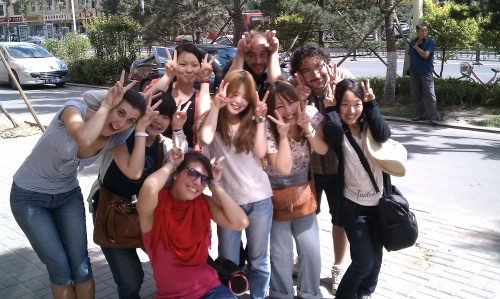 Happy travelers waiting for the bus in Datong
Happy travelers waiting for the bus in Datong
After dinner, some of us went to the center of town, where there was a large night market taking place. Someone in our group commented that this city had a lot more charm than Beijing, and I would have to agree. Everyone was out on the street, shopping or playing or having a late supper in the two plazas next to the city hall. We walked around for a while before sitting down to have a drink at the food court to enjoy the scene. You could tell that Datong did not get nearly as many foreign visitors as Beijing. Everywhere we went, the people stared at us as if we had dropped in on flying saucers. It was a little strange. In Beijing, there are so many foreigners that no one pays you much attention, unless you look for places off the beaten path. In Datong, when you walk down the main street, you feel like a movie star. I have a hard time imagining living with that all the time, as some of the people in Hollywood do.
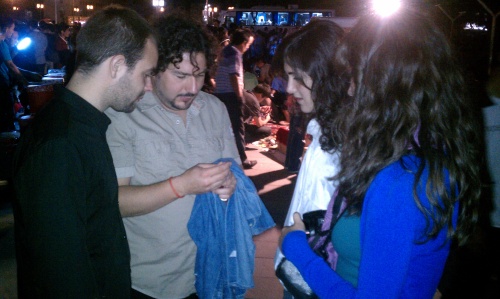 Luis showing off his purchases
Luis showing off his purchases
The next day we got up at 7am to eat breakfast before heading out to the Yun’gang Grotto (Our guide wanted us to go early so that we could get home early, remember?). The Yun’gang grotto is an important site in China and it was obvious that someone in the government was putting large resources into it. They had built a massive, historic-looking new temple for tourists to come visit. (The other way that I know that someone thinks this place is important is because the guides were all women, they were all young and they were all good looking. The boss wants to leave people with a good impression.) A friend of mine and I spent some time speculating about what people would think of these new ‘retro’ constructions (e.g., the new city wall and this temple) five hundred years from now. Because of their size and beauty, would they be like the relics that we visit today, or would the fact that they were built to attract tourists cheapen them and make them something people don’t want to see? I don’t know the answer, but I know that in America lots of people still go to Disneyland each year.
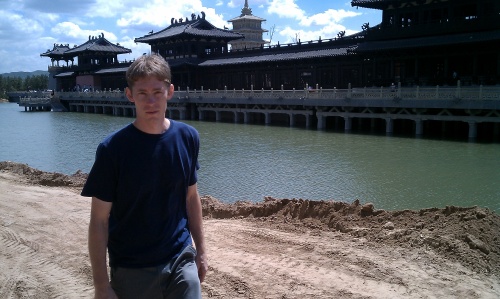 Everything behind me is new
Everything behind me is new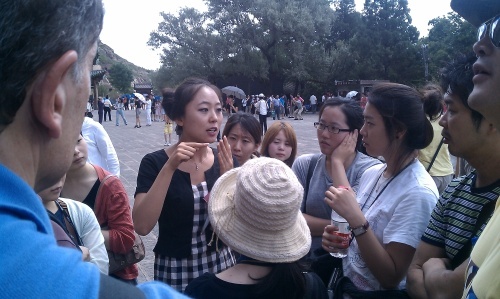 Our guide (plaid dress)
Our guide (plaid dress)
The Grotto is essentially a rock wall that has a number of large (and small) Buddha statues carved inside the rock (Travel China Guide has more info here.) Some of them are visible from the outside, but to see most of them, you have to step into the cave entrances to see them. The craftsmanship is impressive—it must have taken forever for the workers to carve away the stone for the statues. Michelangelo is reported to have said one time that “the figure is already inside the stone, I just have to let it out,” and I couldn’t help but think about the visionaries who saw these massive statues hiding inside the rock wall before the carvers let them out. The statues were impressive for both their size and beauty.
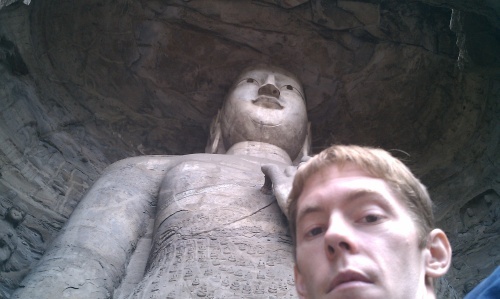
After a while, though, all of the statues began to look the same to me. I commented to a fellow traveler that without knowing the language of the artist for that time period, someone like me cannot really understand what is going on inside the caves. It is similar to visiting the cathedrals in Europe. There is a common language of symbols, and when you know what some of the symbols stand for, it becomes a game to see how each artist has interpreted important characters and events from the history of Christianity. I did not know this language for the Yun’gang Grotto, so after a while I began to look for other ways to entertain myself.
I discovered a new exercise for visiting something large that you might find interesting if you are bored at a tourist stop someday. Starting out right next to the massive wall, I walked backwards while keeping my vision fixed on some of the carvings in the wall. It was interesting because as I stepped back, I realized that magnitude and grandeur of the site. Up close, all you can see is the details of the rock, but with each step back, your perspective changes. You can see more and more of the overall impression that the art gives. It’s a simple thing to do, and might give you something to do if you’re ever waiting for someone. Then again, maybe I’m just easily entertained. . . .
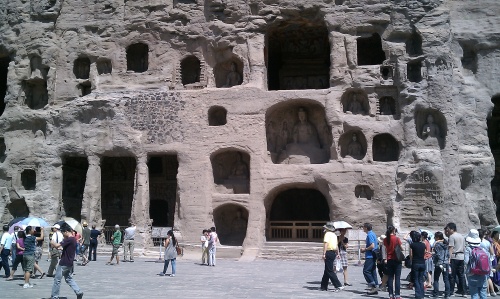 Take a few steps back
Take a few steps back
After a couple hours, we headed back to the bus for our ill-fated ride back to Beijing. I enjoyed our time in Datong and was glad to have seen this part of China. It almost made the bus ride back worth it.